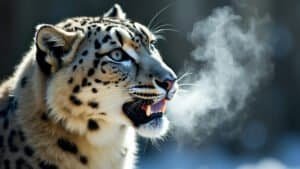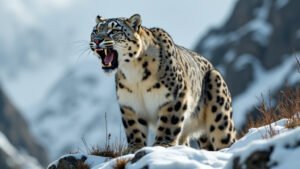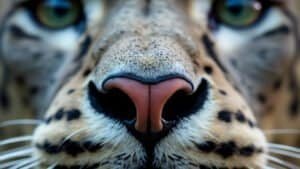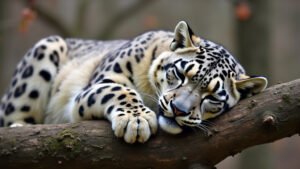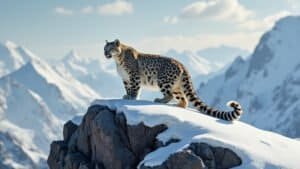Introduction
The snow leopard, known for its elusive nature and striking beauty, has evolved one of the most effective camouflage mechanisms in the animal kingdom. This big cat’s coat pattern is a masterpiece of natural design, allowing it to blend seamlessly into the rocky, snowy environments of its mountainous habitats. In this article, we’ll explore the intricate details of the snow leopard’s coat—its colors, patterns, and textures—that make it virtually invisible to both prey and predators. We’ll also delve into how this camouflage plays a crucial role in the snow leopard’s survival, its effectiveness in various habitats, and how these patterns have evolved and adapted over time
How the Snow Leopard’s Coat Pattern Provides Camouflage
The snow leopard, native to the mountain ranges of Central and South Asia, possesses a coat pattern that is perfectly adapted to its rugged, icy environment. This pattern, consisting of a mix of colors and rosettes, is essential for its survival. The snow leopard’s fur is primarily a pale, smoky-gray color, with white underparts and darker spots scattered across its body. These spots vary in size and shape, ranging from solid black spots on the limbs and head to larger rosettes on the body and tail. The combination of these elements allows the snow leopard to blend seamlessly into the rocky, snow-covered landscapes it inhabits.
The color of the snow leopard’s coat is one of its most vital camouflage tools. The grayish hue of the fur mimics the color of the rocks and boulders commonly found in the high-altitude regions where the snow leopard lives. This neutral tone provides an excellent backdrop that helps the snow leopard avoid detection by both prey and predators. During the winter months, when snow blankets the terrain, the white underparts and the lighter shades of the fur offer an additional layer of concealment, making the snow leopard nearly indistinguishable from the snowy environment.
What Colors and Patterns Are Present in a Snow Leopard’s Coat?
The snow leopard’s coat features a palette of muted colors, including grays, whites, and light browns. These colors are punctuated by black rosettes and spots, which break up the outline of the snow leopard’s body. This type of disruptive coloration is a common camouflage strategy in the animal kingdom, as it makes it difficult for observers to discern the shape of the animal from a distance. The irregular patterns of the rosettes and spots further enhance this effect by blending with the uneven, rocky terrain. The snow leopard’s thick fur also plays a role in its camouflage. The dense fur not only provides insulation against the cold but also adds texture to the coat, helping it merge more effectively with the rugged landscape.
How Does the Snow Leopard’s Coat Mimic Its Natural Environment?
The snow leopard’s natural habitat is characterized by rocky outcrops, steep cliffs, and snowy expanses. The pattern and coloration of its coat are specially adapted to these environments. The rosettes on the snow leopard’s coat resemble the shadows cast by rocks and crevices, creating a visual illusion that makes the animal blend into the background. This mimicry is so effective that even from a relatively close distance, the snow leopard can be nearly invisible when it remains still. Additionally, the snowy landscape of the snow leopard’s habitat is reflected in the lighter tones of its coat, particularly in winter, when these tones help the snow leopard blend into the snow-covered surroundings.
In Which Habitats Does the Snow Leopard’s Camouflage Work Best?
The snow leopard’s camouflage is most effective in the high-altitude mountainous regions of Central Asia, including the Himalayas, the Tibetan Plateau, and the Altai Mountains. These areas are characterized by harsh, rocky terrains with patches of snow that persist year-round. The snow leopard’s ability to blend into these environments is crucial for its hunting strategy, which relies on stealth and surprise. The camouflage works particularly well in areas where the landscape is a mix of snow and exposed rock, allowing the snow leopard to use the contrasting patterns of its coat to merge with the background. This camouflage is less effective in open, flat landscapes or dense forests, which are not typical of the snow leopard’s preferred habitat.
The effectiveness of the snow leopard’s camouflage is also seasonal. During the winter months, the snow leopard’s coat blends more effectively with the snow-covered ground, while in the warmer months, when the snow melts and reveals more of the rocky terrain, the gray and brown hues of the coat provide better camouflage. This seasonal adaptability is crucial for the snow leopard’s survival, as it allows the animal to remain hidden from prey and predators throughout the year
The Role of Camouflage in Snow Leopard Hunting and Survival
Camouflage plays a critical role in the snow leopard’s ability to hunt and survive in its challenging environment. The snow leopard is a solitary predator that relies heavily on stealth to catch its prey. Its ability to remain undetected until the last moment is crucial for a successful hunt, as its prey, which includes animals like blue sheep (bharal), ibex, and other mountain ungulates, is highly alert and capable of evading predators. The snow leopard’s natural camouflage is a key element that allows it to approach its prey without being noticed, increasing its chances of a successful ambush.
How Camouflage Enhances the Snow Leopard’s Hunting Strategy
The snow leopard’s hunting strategy is built around the element of surprise. It typically hunts during dawn and dusk, times when the lighting conditions make its camouflage even more effective. The uneven pattern of rosettes and spots on its coat breaks up its outline, making it difficult for prey to spot the predator against the backdrop of rocks, cliffs, and snow. The snow leopard often stalks its prey from above, using the steep terrain to its advantage. Its camouflage allows it to remain hidden until it is within striking distance, at which point it launches a powerful and swift attack.
The effectiveness of this camouflage is evident in the snow leopard’s hunting success rates. Despite the challenging environment and the difficulty of catching fast-moving prey in steep, rugged terrain, the snow leopard has adapted its behavior and physical traits to optimize its chances. The camouflage allows the snow leopard to get as close as possible to its prey, reducing the distance it needs to cover during the final sprint, which is often the most energy-consuming part of the hunt.
How Effective Is the Snow Leopard’s Camouflage Against Predators?
While the snow leopard is an apex predator with few natural enemies, its camouflage also serves as a defense mechanism. In the rare instances where snow leopards might be threatened by larger predators or by humans, their ability to blend into the environment is a crucial survival tool. For example, when a snow leopard feels threatened, it may remain completely still, relying on its camouflage to avoid detection rather than fleeing. This strategy is particularly effective in the snow leopard’s mountainous habitat, where the terrain offers plenty of opportunities to hide.
Human activity, including poaching and habitat encroachment, poses a significant threat to snow leopards. In areas where snow leopards are hunted for their fur or to protect livestock, their natural camouflage can sometimes be a double-edged sword. While it helps them avoid detection by humans, it can also make it harder for conservationists to locate and protect them. Nonetheless, the snow leopard’s ability to remain unseen is generally a significant advantage in avoiding human threats.
Seasonal Changes in the Snow Leopard’s Coat and Its Impact on Camouflage
The snow leopard’s coat undergoes subtle changes with the seasons, which enhances its camouflage throughout the year. During the winter, the snow leopard’s fur becomes thicker and lighter in color, which helps it blend into the snow-covered environment. This seasonal adaptation is critical in maintaining the effectiveness of its camouflage, as it allows the snow leopard to remain hidden in a landscape that changes dramatically between winter and summer.
In the warmer months, when the snow melts and the rocky terrain is more exposed, the snow leopard’s coat takes on slightly darker and more varied tones, helping it blend into the rocky, barren landscapes. This seasonal variation in the snow leopard’s coat is a perfect example of how animals can adapt to their environments to improve their chances of survival. The ability to change its appearance in response to the environment ensures that the snow leopard’s camouflage remains effective year-round, whether it is hunting prey or avoiding detection by potential threats
Evolution and Adaptation of Snow Leopard Camouflage
The snow leopard’s remarkable camouflage is the result of millions of years of evolution, shaped by the demands of its harsh, mountainous environment. Over time, natural selection has favored individuals with coat patterns and colors that provide better concealment, enabling them to survive, reproduce, and pass on these advantageous traits to their offspring. This evolutionary process has led to the development of a coat that is perfectly suited to the snow leopard’s specific habitat, allowing it to remain hidden from both prey and potential threats.
How the Snow Leopard’s Coat Pattern Has Evolved Over Time
The snow leopard’s coat pattern is a classic example of adaptive evolution, where the traits of an animal develop in response to environmental pressures. The origins of the snow leopard’s distinctive rosettes and pale coloration can be traced back to its ancestors, which likely lived in a variety of environments, including forested areas where spots and rosettes are common camouflage patterns. As snow leopards adapted to life in high-altitude regions, their coat patterns evolved to better match the rocky and snowy landscapes of their new habitat.
Genetic studies have shown that the snow leopard’s closest relatives are tigers, which also have a pattern of stripes that provides camouflage in dense forests. However, as the snow leopard’s ancestors moved into more open, mountainous terrain, the patterns of their coats gradually shifted from stripes to rosettes. These rosettes are more effective in breaking up the outline of the animal against a backdrop of rocks and snow. The pale coloration of the snow leopard’s coat also evolved as a response to its environment, allowing it to blend into the lighter, rocky landscapes at higher altitudes.
Similar Camouflage Patterns in Other Animals
Camouflage is a common survival strategy in the animal kingdom, and the snow leopard shares this trait with several other species. For example, the jaguar, which lives in the dense forests of South and Central America, also has a coat covered in rosettes. However, while the jaguar’s rosettes are designed to blend in with the dappled sunlight filtering through the forest canopy, the snow leopard’s rosettes mimic the shadows and textures of rocky outcrops in mountainous terrain.
Another animal with a similar camouflage strategy is the Arctic fox. Like the snow leopard, the Arctic fox has a coat that changes with the seasons, becoming white in the winter to blend in with the snow and brown in the summer to match the tundra. This seasonal adaptation is crucial for survival in environments where the landscape changes dramatically throughout the year. The snow leopard’s ability to change the shade and thickness of its coat is an example of convergent evolution, where different species develop similar traits in response to similar environmental pressures.
The Impact of Climate Change on Snow Leopard Camouflage
As the global climate continues to change, the snow leopard’s environment is also undergoing significant alterations. Warming temperatures are leading to the retreat of glaciers and reduced snow cover in some parts of the snow leopard’s range, which could have profound effects on the effectiveness of its camouflage. As the landscape changes, the snow leopard’s pale, snowy camouflage may become less effective, potentially making it more vulnerable to detection by both prey and predators.
Climate change could also lead to shifts in the snow leopard’s habitat, pushing the animals to higher altitudes where the terrain may be more barren and rocky. While the snow leopard’s coat is well-suited to blend in with rocks, the loss of snow cover could still impact its ability to remain undetected in certain areas. Conservation efforts must consider these potential changes and the challenges they pose for the snow leopard’s survival.
Moreover, as the snow leopard’s habitat shrinks and becomes more fragmented due to climate change, the genetic diversity of the population could decrease, limiting the species’ ability to adapt to new environmental conditions. This could result in slower evolutionary changes, potentially making it harder for the snow leopard to maintain its effective camouflage over time
Conclusion
The snow leopard’s coat pattern is a prime example of nature’s ingenuity, developed over millennia to provide the perfect camouflage in its rugged, mountainous habitat. This camouflage is not just a passive trait but a vital tool for survival, allowing the snow leopard to hunt effectively and avoid detection by both prey and potential predators. The intricate combination of colors and rosettes in its fur mimics the rocky, snowy landscapes it calls home, providing an almost seamless blend with the environment. As we’ve explored, this camouflage is highly adaptable, changing with the seasons and evolving in response to the unique challenges of the snow leopard’s habitat.
However, the ongoing threat of climate change poses new challenges, potentially disrupting the delicate balance that has allowed the snow leopard to thrive. As its environment changes, the snow leopard’s ability to camouflage may be compromised, making conservation efforts more crucial than ever. Understanding and preserving this incredible species involves not just protecting its habitat but also recognizing the importance of the evolutionary traits that have allowed it to become the elusive, majestic creature it is today




